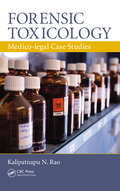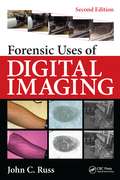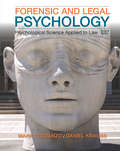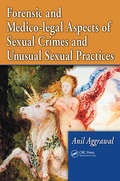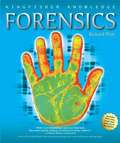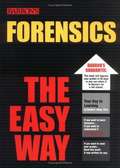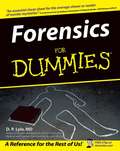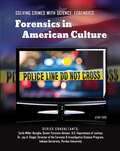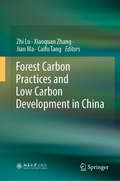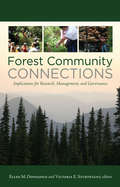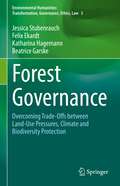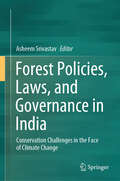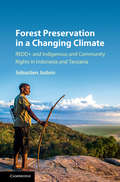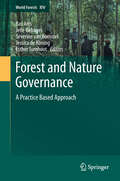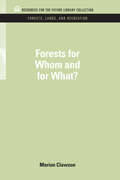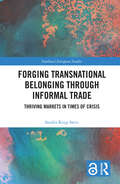- Table View
- List View
Forensic Toxicology: Medico-Legal Case Studies
by Kalipatnapu N. RaoModern technology using state-of-the-art equipment can now identify almost any toxin relevant to a legal issue. Techniques include gas chromatography, mass spectrometry, high-pressure liquid chromatography, and the combination of these methods. Forensic Toxicology: Medico-legal Case Studies demonstrates how the science of forensic toxicology acts a
Forensic Uses of Digital Imaging
by John C. Russ Jens Rindel P. LordThe ability to work with, and retrieve images, is vital to forensic and criminal case work. During a five-decade-long career, author John C. Russ has taught methods for image processing and measurement to thousands of students. Forensic Uses of Digital Imaging, Second Edition distills his classroom and workshop material to present the information m
Forensic Victimology: Examining Violent Crime Victims in Investigative and Legal Contexts
by Brent E. Turvey Wayne PetherickThis new textbook provides students with the basic principles and practice standards of forensic victimology -the scientific study of victims for the purposes of addressing investigative and forensic issues. It provides case-based coverage with original insights into the role that victimology plays in the justice system, moving beyond the traditional theoretical approaches already available. The purpose of this textbook is to distinguish the investigative and forensic aspects of victim study as a necessary adjunct to the field of victimology. It identifies forensic victimologists in the investigative and forensic communities and provides them with methods and standards of practice needed to be of service. This book is intended to educate students on the means and rationale for performing victimological assessments with a scientific mindset. Forensic Victimology is designed specifically for teaching the practical aspects of this topic, with "hands on" real-life case examples and an extensive online Instructor's manual featuring summaries, key terms, and test questions for every chapter. * Applied victimology for students and caseworkers performing objective examinations as opposed to theoretical victimology that studies victim groups and crime statistics. * First ever textbook detailing a mandate, scope and methods for forensic victimologist practitioners. * Provides a critical / scientific counterbalance to existing mainstream texts approaching general victimology with a pro-victim bias. * Written by practitioners of forensic victimology in the investigative, forensic, mental health, and academic communities.
Forensic and Legal Medicine: Clinical and Pathological Aspects
by Jason Payne-James Roger ByardA comprehensive and accessible resource covering all aspects of forensic and legal medicine. The text provides a foundation for those working in both the clinical and forensic aspects of care and will also be an asset to those involved in the police or judicial systems. Including clear guidelines for practical applications, and further enhanced by its many illustrations and case examples, this text is a valuable resource in an increasingly complex field. The authoritative work is written by those who have extensive experience for a wide audience including, but not limited to, forensic pathologists, general pathologists, pediatric pathologists, forensic physicians, forensic scientists, coroners, emergency department physicians, judges and legal practitioners. Chapter 62 of this book is freely available as a downloadable Open Access PDF at http://www.taylorfrancis.com under a Creative Commons [Attribution-Non Commercial-No Derivatives (CC-BY-NC-ND)] 4.0 license.
Forensic and Legal Psychology
by Mark Costanzo Daniel KraussUsing research in clinical, cognitive, developmental, and social psychology,Forensic and Legal Psychologyshows how psychological science can enhance the gathering and presentation of evidence, improve legal decision-making, prevent crime, rehabilitate criminals, and promote justice. Although the emphasis is on psychological research, the textbook makes extensive use of actual cases and real trials to engage students and to illustrate the relevance of research findings. Written in a clear, student-friendly style,Forensic and Legal Psychologyis designed for both the psychology and law AND forensic psychology class. Visit the preview site for more information:www. worthpublishers. com/costanzokrausspreview
Forensic and Legal Psychology
by Mark Costanzo Daniel KraussDrawing on a combined three decades of teaching experience, Costanzo and Krauss help students explore the fascinating intersections where psychology and the law meet, in an excitingly written textbook that presents the latest research in the context of dozens of real cases. As before, the new edition draws on extensive research in social, cognitive, clinical, and developmental psychology to explore virtually every aspect of the legal system studied by psychologists, emphasizing the ways research and theory deepen our understanding of key participants (e. g. , criminals, police, victims, lawyers, witnesses, judges, and jurors) and basic psychological processes (e. g. , decision-making, persuasion, perception, memory, and behavior change).
Forensic and Legal Psychology: Psychological Science Applied to Law
by Mark Costanzo Daniel KraussCostanzo and Krauss show students how psychological science can be used to enhance the gathering of evidence, improve legal decision making, reduce crime, and promote justice. With the integration of fascinating real trials, cases and other examples of the legal system in action, the authors illustrate how research and theory can deepen our understanding of suspects, criminals, police officers, victims, lawyers, witnesses, judges, and jurors. Costanzo and Krauss accessibly illustrate the relevance of key research findings in social, cognitive, clinical, and developmental psychology to virtually every aspect of the legal system psychologists have studied
Forensic and Medico-legal Aspects of Sexual Crimes and Unusual Sexual Practices
by Anil AggrawalFrom sexual abuse and fetishism to necrophilia and sadomasochism, this unique volume identifies fourteen classifications of unusual sexual pathologies. Emphasizing the physical and psychological aspects of sexuality itself, the book presents detailed comparisons of legal and medical definitions, historical aspects, current incidence, and geographic
Forensics
by Richard PlattExplore the crime lab with Forensics and discover how detectives use science to solve crimes. From the scene of the crime to a criminal's conviction, discover how the marks of blood, footprints, and fingerprints can lead the police to criminals. Find out how specialists can match trace evidence, such as a single hair found on a victim, to the murderer. Learn how famous crimes were solved and, like a true detective, find out whether it was arson, poison, or murder.
Forensics The Easy Way
by Harold H. TrimmThe science of forensics and the crime investigation lab have become an increasingly important aspect of police work. This brand-new Easy Way title introduces criminology students and law enforcement candidates to forensics in four major sections: Introduction to Forensic Science, The Physical Sciences, Physical Evidence, and The Future of Forensic Science. Among the topics explored are applications of the sciences of physics and chemistry to forensics, physical evidence, body fluids, explosives and incendiaries, firearms, fingerprints, DNA evidence, and many more. Discussion of future trends includes retinal scans and other ID systems, computer databases and searches, and more. Review questions with answers appear at the end of each chapter. Barron's Easy Way books introduce a variety of academic and practical subjects to students and general readers in clear, understandable language. Ideal as self-teaching manuals for readers interested in learning a new career-related skill, these books have also found widespread classroom use as supplementary texts and brush-up test-preparation guides. Subject heads and key phrases that need to be learned are set in a second color.
Forensics for Dummies
by D. P. LyleForensics for Dummies is an introduction to the field of forensic science, covering a broad range of forensic topics in a clear and concise fashion. It includes many examples of how these techniques are applied in real-life situations. Case studies are included throughout the book to illustrate how forensic science was used to solve famous cases. This book is an excellent starting point for fresher and for those familiar with many forensic topics, it serves to refresh and expand the knowledge.
Forensics for Kids: The Science and History of Crime Solving, With 21 Activities (For Kids series)
by Melissa RossWhat kind of science does it take to solve a crime? Forensics for Kids provides the complete history of forensic science, giving readers a comprehensive understanding of crime-solving development and the birth of modern forensics. Author Melissa Ross uncovers fascinating stories, famous cases, pioneers who led the way, and what forensics might look like in the future. Twenty-one engaging activities offer readers experiential learning of the science and history of forensics. Kids have the opportunity to hear from experts in the field, explore forensic labs and tools, and delve into subjects such Hitler's forged diaries and the mystery of General Jackson's arm. Kids can become the next real-life Sherlock Holmes or Nancy Drew after exploring the science of forensics.
Forensics in American Culture: Obsessed With Crime (Solving Crimes With Science: Forensics)
by Jean FordWhy are programs such as CSI, Law & Order, and Cold Case so popular? Because our culture is fascinated with crime--and these television shows reveal investigators' procedures and secrets. With so many forensic-based television programs, it might seem that North America's morbid curiosity is a new phenomenon. The truth is, however, that humanity have always been fascinated by that which also frightens them. What's more, humans are attracted to puzzles--and forensic science offers opportunities to solve mysteries while at the same time "catching the bad guys." Modern media has only magnified the tendencies of previous generations. This book takes a look at the ways this fascination with crime shapes modern news media, television programming, movies, and the Internet. It also provides information on the real-life opportunities for forensic careers. Forensic science is more than just a cultural obsession--it's a fast-growing professional field. Forensics in American Culture will reveal this field's intriguing mixture of science, mystery, excitement, and justice.
Forensics: What Bugs, Burns, Prints, DNA, and More Tell Us About Crime
by Val McDermidVal McDermid is one of the finest crime writers we have, whose novels have captivated millions of readers worldwide with their riveting narratives of characters who solve complex crimes and confront unimaginable evil. In the course of researching her bestselling novels McDermid has become familiar with every branch of forensics, and now she uncovers the history of this science, real-world murders and the people who must solve them. The dead talk to the right listener. They can tell us all about themselves: where they came from, how they lived, how they died, and, of course, who killed them. Forensic scientists can unlock the mysteries of the past and help serve justice using the messages left by a corpse, a crime scene, or the faintest of human traces. Forensics draws on interviews with some of these top-level professionals, ground-breaking research, and McDermid’s own original interviews and firsthand experience on scene with top forensic scientists. Along the way, McDermid discovers how maggots collected from a corpse can help determine one’s time of death; how a DNA trace a millionth the size of a grain of salt can be used to convict a killer; and how a team of young Argentine scientists led by a maverick American anthropologist were able to uncover the victims of a genocide. It’s a journey that will take McDermid to war zones, fire scenes, and autopsy suites, and bring her into contact with both extraordinary bravery and wickedness, as she traces the history of forensics from its earliest beginnings to the cutting-edge science of the modern day.
Forest Carbon Practices and Low Carbon Development in China
by Zhi Lu Jian Ma Xiaoquan Zhang Caifu TangThis is the first book illustrating China’s forest carbon projects. It includes an analysis of the policy and future development trends of China’s forest carbon market and showcases the country’s most representative forest carbon projects. Accordingly, it offers a valuable resource for all policymakers and researchers interested in forest carbon, as well as project developers and engineers involved in forest carbon projects.
Forest Community Connections: "Implications for Research, Management, and Governance"
by Ellen M Donoghue Victoria E SturtevantThe connections between communities and forests are complex and evolving, presenting challenges to forest managers, researchers, and communities themselves. Dependency on timber extraction and timber-related industries is no longer a universal characteristic of the forest community. Remoteness is also a less common feature, as technology, workforce mobility, tourism, and 'amenity migrants' increasingly connect rural to urban places. Forest Community Connections explores the responses of forest communities to a changing economy, changing federal policy, and concerns about forest health from both within and outside forest communities. Focusing primarily on the United States, the book examines the ways that social scientists work with communities-their role in facilitating social learning, informing policy decisions, and contributing to community well being. Bringing perspectives from sociology, anthropology, political science, and forestry, the authors review a range of management issues, including wildfire risk, forest restoration, labor force capacity, and the growing demand for a growing variety of forest goods and services. They examine the increasingly diverse aesthetic and cultural values that forest residents attribute to forests, the factors that contribute to strong and resilient connections between communities and forests, and consider a range of governance structures to positively influence the well being of forest communities and forests, including collaboration and community-based forestry.
Forest Governance: Overcoming Trade-Offs between Land-Use Pressures, Climate and Biodiversity Protection (Volume 3) (Environmental Humanities: Transformation, Governance, Ethics, Law)
by Katharina Hagemann Felix Ekardt Jessica Stubenrauch Beatrice GarskeThis book analyses and develops overarching concepts for forest policy and forest governance and includes a detailed investigation into the historical discussion on forests. It examines opportunities and limits for negative emissions in a sector that – like peatlands – appears significantly less ambivalent compared to highly technical large-scale forms of climate geoengineering. The analysis shows that the binding climate and biodiversity targets under international law are much more ambitious than most people assume. Measured against that, the volume critically reviews the potentials of afforestation and reforestation for climate mitigation, which is often presented as the new saviour to fulfil the commitments of the Paris Agreement and to reach climate neutrality in the future. It becomes clear that ultimately only biodiverse and thus resilient forests can function as a carbon sink in the long term. The volume shows that the existing European and international forest governance approaches fail to comply with these targets and insights. Furthermore, the book develops a bundle of policy measures. Quantity governance systems for livestock farming, fossil fuels and similar drivers of deforestations represent the most important approach. They are most effective when not directly targeting forests due to their heterogeneity but central damaging factors. With regard to the dominant regulatory and subsidy-based governance for forests we show that it remains necessary to supplement these quantity governance systems with certain easily graspable and thus controllable regulatory and subsidy regulations such as a regulatory protection of old-growth forests with almost no exceptions; extension of the livestock-to-land-ratio established in organic farming to all farming; far-reaching restriction of bioenergy use to certain residues flanked by import bans; and a national and international complete conversion of all agricultural and forest subsidies to “public money for public services” to promote nature conservation and afforestation in addition to the quantity control systems.
Forest Policies, Laws, and Governance in India: Conservation Challenges in the Face of Climate Change
by Asheem SrivastavThe book delves into the intricate relationship between India’s forest governance, laws, and policies over time, examining their effects on the quality and coverage of the country’s forests. Historically, especially during the British era and the initial phase following independence, forests were valued for timber, leading to increased deforestation to fulfill the rising demands of shipbuilding, railways, residential construction, and industry. The economic benefits derived from converting forest land for developmental purposes were a key factor in this trend. However, recent statistics indicate that except Maharashtra, most of the forest rich states including MP and Chhattisgarh have lagged in economic development. The history of overexploitation and diversion for non-forestry use has also led to less forest area per capita. India has lost tree biomass much more than its productivity potential, and the average biological productivity of Indian forest is much below the global average. It is extremely important to restore the health of natural forests which are, by far, the best and a highly cost-effective carbon sequestering machine provided by nature. The book also provides research data, both at national and global scales to convincingly put forward the contention that natural forests are sine qua non and under no circumstances can farm and roadside plantations, tea and coffee plantations, and orchards be a substitute for natural forest for three important reasons: (1) the influence of natural forest on rainfall, (2) the complexity in maintaining energy flow, and (3) the impact of natural forest or deforested sites on soil.
Forest Preservation in a Changing Climate: REDD+ and Indigenous and Community Rights in Indonesia and Tanzania
by Sébastien JodoinThis book provides a comprehensive socio-legal examination of how global efforts to fight climate change by reducing carbon emissions in the forestry sector (known as REDD+) have affected the rights of Indigenous Peoples and local communities in developing countries. Grounded in extensive qualitative empirical research conducted globally, the book shows that the transnational legal process for REDD+ has created both serious challenges and unexpected opportunities for the recognition and protection of indigenous and community rights. It reveals that the pursuit of REDD+ has resulted in important variations in how human rights standards are understood and applied across multiple sites of law in the field of REDD+, with mixed results for Indigenous Peoples and local communities in Indonesia and Tanzania. With its original findings, rigourous research design, and interdisciplinary analytical framework, this book will make a valuable contribution to the study of transnational legal processes in a globalizing world. This title is also available as Open Access. Explores the opportunities as well as the challenges that REDD+ has created for the protection of human rights in developing countries. Provides comprehensive analysis of the implications of REDD+ for the rights of Indigenous Peoples and local communities. Original findings developed through extensive fieldwork provide new insights for those working on the intersections of REDD+ and rights.
Forest and Nature Governance
by Jelle Behagel Bas Arts Jessica De Koning Esther Turnhout Séverine Van BommelToday, problems such as deforestation, biodiversity loss and illegal logging have provoked various policy responses that are often referred to as forest and nature governance. In its broadest interpretation, governance is about the many ways in which public and private actors from the state, market and/or civil society govern public issues at multiple scales. This book takes a fresh perspective on the study of forest and nature governance. Departing from 'practice theory', and building upon scholars like Giddens, Bourdieu, Reckwitz, Schatzki and Callon, it seeks to move beyond established understandings of institutions, actors, and knowledge. In so doing, it not only presents an innovative conceptual and methodological framework for a practice based approach, but also rich case studies and ethnographies. Finally, this book is about how actors involved in governance talk about and work with trees, forests, biodiversity, wildlife, and so on, while acting upon forest policies, environmental discourses, codes of conduct, or scientific insights.
Forests for Whom and for What? (RFF Forests, Lands, and Recreation Set)
by Marion ClawsonClawson is concerned here not so much with what forest policy should be, but more with the criteria by which it should be determined. He lists such questions as how much land to devote to forests, how much timber to harvest and the best means of harvesting it, and the compatibility or incompatibility of forest uses as the issues to be dealt with in formulating forest policy. Originally published in 1975
Forests in International Law
by Anja EikermannThis book investigates the potential need for an international convention on forests and establishes a multifunctional concept of forests as a cornerstone for international forest regulation. Accordingly, it examines a variety of international instruments pertaining directly or indirectly to forests and explores their entangled, fragmented nature. While contending that the lack of consistency in international law impedes the development of a stand-alone international forest convention, at the same time it argues that the lessons learned from fragmentation as well as from the history of forest discourse on the international level open up new options for the regulation of forests in international law, based on (new) concepts of coordination and cooperation.
Forging Capitalism
by Ian KlausVice is endemic to Western capitalism, according to this fascinating, wildly entertaining, often startling history of modern finance. Ian Klaus's Forging Capitalism demonstrates how international financial affairs in the nineteenth century were conducted not only by gentlemen as a noble pursuit but also by connivers, thieves, swindlers, and frauds who believed that no risk was too great and no scheme too outrageous if the monetary reward was substantial enough. Taken together, the grand deceptions of the ambitious schemers and the determined efforts to guard against them have been instrumental in creating the financial establishments of today. In a story teeming with playboys and scoundrels and rich in colorful and amazing events, Klaus chronicles the evolution of trust through three distinct epochs: the age of values, the age of networks and reputations, and, ultimately, in a world of increased technology and wealth, the age of skepticism and verification. In today's world, where the questionable dealings of large international financial institutions are continually in the spotlight, this extraordinary history has great relevance, offering essential lessons in both the importance and the limitations of trust.
Forging Transnational Belonging through Informal Trade: Thriving Markets in Times of Crisis (Southeast European Studies)
by Sandra King-SavicAnalyzing informal trading practices and smuggling through the case study of Novi Pazar, this book explores how societies cope when governments no longer assume the responsibility for providing welfare to their citizens. How do economic transnational practices shape one’s sense of belonging in times of crisis/precarity? Specifically, how does the collapse of the Ottoman Empire – and the subsequent migration of the Muslim Slav population to Turkey – relate to the Yugoslav Succession Wars during the 1990s? Using the case study of Novi Pazar, a town in Serbia that straddles the borders of Montenegro, Serbia and Kosovo that became a smuggling hub during the Yugoslav conflict, the book focuses on that informal market economy as a prism through which to analyze the strengthening of existing relations between the émigré community in Turkey and the local Bosniak population in the Sandžak region. Demonstrating the interactive nature of relations between the state and local and émigré communities, this book will be of interest to scholars and students interested in Southeastern Europe or the Yugoslav Succession Wars of the 1990s, as well as social anthropologists who are working on social relations and deviant behavior.
Forging a Convention for Crimes against Humanity
by Leila Nadya SadatCrimes against humanity were one of the three categories of crimes elaborated in the Nuremberg Charter. However, unlike genocide and war crimes, they were never set out in a comprehensive international convention. This book represents an effort to complete the Nuremberg legacy by filling this gap. It contains a complete text of a proposed convention on crimes against humanity in English and in French, a comprehensive history of the proposed convention, and fifteen original papers written by leading experts on international criminal law. The papers contain reflections on various aspects of crimes against humanity, including gender crimes, universal jurisdiction, the history of codification efforts, the responsibility to protect, ethnic cleansing, peace and justice dilemmas, amnesties and immunities, the jurisprudence of the ad hoc tribunals, the definition of the crime in customary international law, the ICC definition, the architecture of international criminal justice, modes of criminal participation, crimes against humanity and terrorism, and the inter-state enforcement regime. "
